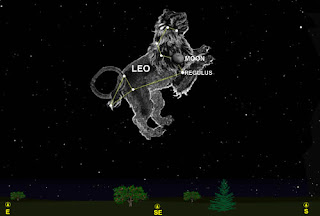I noticed Venus earlier on my way home just after sunset in the NW, really can’t miss it. It is really cool to look at the sky and point to an object and say with confidence, this is Venus. This of course built my confidence to be able to recognize all the other stars and constellations. At shortly after 10pm I was at my favorite spot and ready to do my observing. It was cooler than I thought it would be, quiet and dark, well sort of dark. It just does not get completely dark that close to the city. First thing I did I looked for Venus, but Venus was already below my observable horizon. That’s OK, I discovered Venus earlier, so next I looked for Gemini. Directly W, at an altitude of about 20o and there it is, the constellation Gemini… or is it? I am not sure! I think I observed Pollux and Alpha Geminhorum, the two stars defining the upper limit of the constellation, the rest, I am not sure. Looking at the star wheel did not help, it only confused me more. Next to Gemini is Canis Minor, a very simple constellation, a horizontal line, two stars about 4o apart at an altitude of about 20o. I think I got this one right on. Next I was looking for the constellation Cancer which should be about 10o above Canis Minor and looks like an upside down Y. Not a chance, I did not see that constellation. I did see the planet Mars that was right in the constellation, so I knew where to look, but I did not see the upside down Y.
 Next to cancer is Leo, just a bit further S and higher up in the sky. All I can say, I think I did see part of Leo. I think I did identify the brightest star, Regulus in the constellation. Leo is a big constellation, from the head of the Lion to the tale it is close to 30o, easy to get confused. I wonder how the ancient made a Lion out of all those stars. I think there was more involved than just looking at the stars. Straight above Leo was the familiar Big Dipper, or Ursa Major. From the big dipper I always find my way to the North Star. The two stars I was looking for, Arcturus in the SW and at an altitude of 50o and Alpha Virgins in the SSE at an altitude of just a bit more than 25o, I am sure I identified Arcturus, but not Alpha Virgins. Looking to the S is looking towards Seattle, and the light pollution from the city is just too great to make a positive identification.
Next to cancer is Leo, just a bit further S and higher up in the sky. All I can say, I think I did see part of Leo. I think I did identify the brightest star, Regulus in the constellation. Leo is a big constellation, from the head of the Lion to the tale it is close to 30o, easy to get confused. I wonder how the ancient made a Lion out of all those stars. I think there was more involved than just looking at the stars. Straight above Leo was the familiar Big Dipper, or Ursa Major. From the big dipper I always find my way to the North Star. The two stars I was looking for, Arcturus in the SW and at an altitude of 50o and Alpha Virgins in the SSE at an altitude of just a bit more than 25o, I am sure I identified Arcturus, but not Alpha Virgins. Looking to the S is looking towards Seattle, and the light pollution from the city is just too great to make a positive identification.This was a great evening of looking at the stars, but I must admit, finding constellations, especially big constellations such as Leo is not easy. It is easy to get confuse which star belongs to which constellation. What really helped me was to plan out what to look at. For next time I will improve my planning, in addition to the general direction and the altitude, I will add how big the constellations are. That should help me to better define the boundaries of a given constellation. Looking forward to the next clear night.


No comments:
Post a Comment